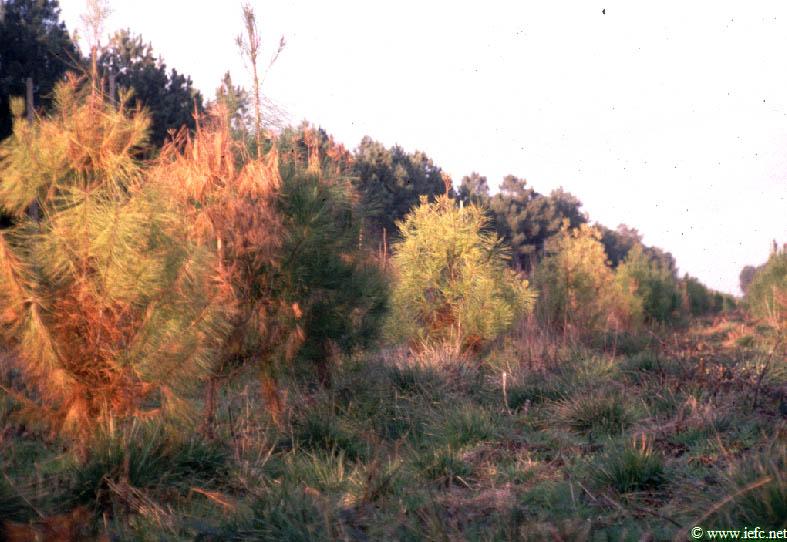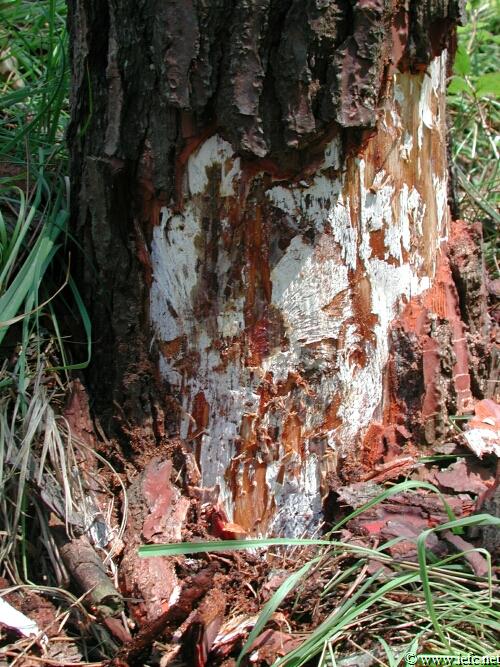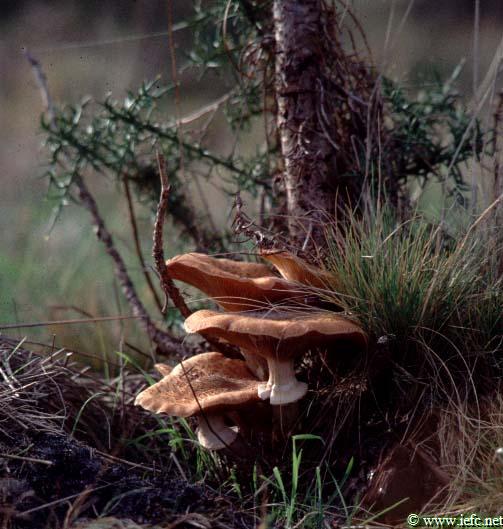Armillaria root disease
Armillaria ostoyae (Basidiomycota, Agaricales)
Synonyms: Armillaria obscura, A. mellea var. obscura, A. polymyces, A. montagnei var. umbrinolutea.
Armillaria root rot, Shoestring root rot, Honey mushroom, Mushroom root rot
Host tree
Mainly pine species such as Maritime (Pinus pinaster), Mountain (P. uncinata), Monterey (P. radiata), Scots (P. sylvestris) and Loblolly pine (P. taeda).
Identification
- Very rapid crown decline when the whole root system is invaded: foliage yellowing, then turning red and brown (Photo 1).
- On trees with crown dieback and on those recently killed presence of creamy-white mycelial fans under the bark of the root collar (Photo 2). On pines killed for a long time, fans can turn into brown to black rhizomorphs.
- In the soil and at the root collar of infected trees, brown black rhizomorphs (shoestrings) growing out of the root bark.
- In November-December, clusters of fruit bodies growing from mycelial fans in the host (roots, stem of dead trees, stumps (Photo 3)) or from rhizomorphs in the soil (Photo 4). Fruit bodies are brown coloured, with brown scales on the cap and the ring and with a thick-set stipe.
- Methods for species identification from rhizomorphs or infected wood are well developed in specialised laboratories.
Damage
- A. ostoyae is fatal to trees. Frequently mortality occurs without other stress factors.
- Disease is present at all stand ages. Losses can be spectacular in the first 5-7 years (in both plantations and natural pine forests) and then mortality declines. In adult stands, often disease centres with dead and dying trees occur.
Biology
- The fungus is a primary pathogen on pines. It can also act as a secondary parasite or saprophyte, even on deciduous trees.
- Armillaria spreads from tree to tree by root contact or by means of its rhizomorphs in the soil. The role of the spores in spreading the disease is not well known.
- After rhizomorph penetration, A. ostoyae invades roots by means of mycelial fans.
- After tree death, the fungus can survive in stumps and dead roots for, at least, 50 years as mycelia or rhizomorphs.
Risk factors
- Armillaria root disease is found frequently on soils with low pH and low nutrient availability.
- Incidence of Armillaria root disease increases with increasing sand content of the surface mineral horizon
- The disease can be spread by ploughing.
Pest management
Preventive measurements
- In stands with disease centres, dig trenches of at least 1 m deep to isolate infected trees from healthy parts.
- When establishing new plantations, take care in site preparation to prevent dissemination of the pathogen.
- Reforest infected sites with hardwoods when possible.
- Biological control, promising in vitro, is not yet operational in forests.
- Remove the stumps in heavily infected stands.
Curative control
- The use of chemical soil fumigants, used in orchards, vineyards and floriculture, is not allowed in forests.




